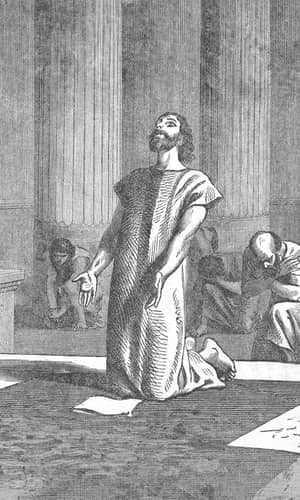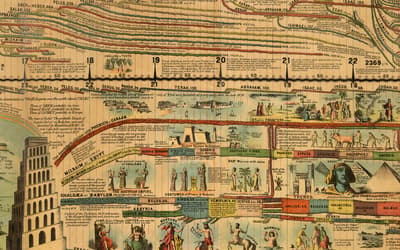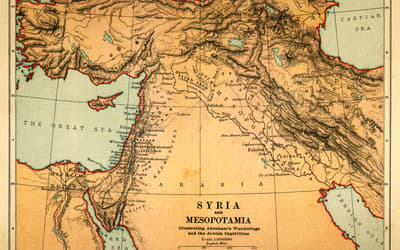The views expressed in this paper are those of the writer(s) and are not necessarily those of the ARJ Editor or Answers in Genesis.
Abstract
This is an outline of the life and reign of Hezekiah King of Judah, from the biblical and Assyrian records. Hezekiah’s rule is one which has been associated with significant chronological controversy, specifically a claimed 12-year gap if the biblical chronology is wrongly understood and correlated with the known chronology of Assyrian kings. This paper attempts to firmly lay out the chronology of this period from the details now available, aligning Hezekiah’s accession to the throne to 716/15 B.C. during the reign of Sargon II of Assyria.
Introduction
This paper is not for the purpose of adding new information to an already well-debated subject but simply to confirm that the chronology of Thiele (1983) (with modification by other authors) for the period surrounding the life of Hezekiah stands essentially correct. As such it is not the intention to deal with the minutiae of dating (such as “months” involved), but to uphold the overall figures involved.
The life of Hezekiah reveals the story of a good, but flawed king. It also reveals a serious controversy in Bible chronology. Hezekiah came to the throne on the death of his profligate father Ahaz (also known as Jehoahaz) without any evidence of co-regency. It is at this point that the first controversy occurs. But in order to outline his life satisfactorily, I will do so in brief first:
- Ascends to the throne
- Implements reforms.
- Attacks the Philistines.
- Is attacked by Sennacherib (first attack); succumbs and pays tribute.
- Falls sick and is healed with a promise of 15 more years.
- Receives the Babylonian ambassadors shortly after his healing.
- Backslides from faithfulness to God.
- Is attacked the second time by Sennacherib but, trusting God, is delivered. The Assyrian army is decimated, and Sennacherib is assassinated by his sons a few years later.
Hezekiah’s Accession
Hezekiah’s accession is correlated with Northern Israel’s kings only in the book of 2 Kings (2 Kings 18:1, 9, 10:2; 2 Kings 17:1 is also relevant). The problem then arises against the known chronology of the Assyrian kings who were heavily operative at that time and in that area. And it becomes obvious that any correlation of the two chronologies produces a problem of a 12-year gap, a problem with which chronologers had wrestled for years without satisfactory results until the thesis of Edwin Thiele (1983). But Thiele’s theory has produced a serious controversy with Bible students, and many assumed answers have been put forward. Bible students falling back on their perceived understanding of the authority of Scripture have often branded Thiele as attacking such, and argue that the problem of synchronization relates to mistakes in the Annals and eponyms of the Assyrians.
In Defense of Thiele’s Overall Chronology of the Period
Two possible solutions are here suggested to resolve the problem of the 12-year gap. First, a brief overview and defence of Edwin Thiele’s thesis will be given. Second, the research of McFall (2008) will be used to modify Thiele’s original theory.
Thiele’s Initial Conclusions
If we are to assume that the collation statements of 2 Kings are unchangeable and absolute, and have not been corrupted, then the Assyrian chronology must give way. On the other hand, if we accept that the Assyrian history is essentially correct, then a problem exists in our understanding of the above-mentioned Bible statements.
I am not intending to repeat all of Thiele’s arguments, which are substantial. If interested, the reader needs to access Thiele’s works directly for the details. But I will outline the points made by Thiele (1983) with which, at this point in his discussion, I agree.
- The original manuscripts of the history of Israel’s kings were held by the schools of prophets (2 Kings 2:3,5,7), as mentioned several times throughout the Scriptures (1 Chronicles 29:29; 2 Chronicles 13:22, 20:34). Thiele (1983, 176) asks: “Who would be in possession of such detailed information concerning prophetic activity, and who would be the most apt to pass it on to posterity? Certainly not the official annalists in court employ. And who would be in a better position to know and record the words and thoughts and rebukes of the prophets but the prophets themselves?”
- These original annals (which here I will call the original autographs) were then over time collated together, most often close to the contemporary periods.
- After the fall of the Jehu Dynasty, a time of severe turmoil ensued, including assassinations and multiple invasions by the Assyrians. Many of the prophets would have fled to southern Judah with their autographs (but not yet collated), where again further conflict arose.
- It was many years later before a collation of the autographs of the reigns of these later kings and Judah’s Hezekiah was finally made. The collation almost certainly took place after Judah’s fall, just under 200 years later (2 Kings 17:19–20, 41). At that stage, some political events were obscured, and the collators worked with the basic records at hand.
- The problem appears to be the parallel reign of competing Israelite kings on either side of the Jordan, with pro- or anti-Assyrian allegiances, for a period of 12 years. This division lasted until the anti-Assyrian Pekah, who previously had feigned servitude as a military captain, unified Israel (2 Kings 15:25).
- Thiele concludes that Hoshea’s reign in Northern Israel had ended before Hezekiah came to the throne in 716/15 B.C. The result, as shall be shown, is a clear and matching whole synchronism between the Bible’s and Assyria’s chronologies.
As we proceed with the history, more of the reasons for Thiele’s conclusions will become evident, but with this solution, the problem lies with the way one regards collation statements. If they are to be regarded specifically as conclusions inspired by the Holy Spirit, then the problem persists. But if like chapter and verse allocations (which often can be shown to be less than perfect), one can conclude that human interpretation has been the guiding hand, then these verses embodying collation statements can be seen to be subject to the difficulties of the collator. Thereby the problem falls away without any implications of a failure of scriptural authority—which rests upon the original autographs. And, Thiele (1983, 135) has certainly not made any such attack on the scriptural authority:
They were the product of some late hand and not of a contemporary recorder. They were the result of late calculation rather than of contemporary observation and recording. . . .The men who produced them were sincere in their purpose to set forth a pattern of reigns in harmony with the facts as they understood them.
Again, Thiele (1983, 140) states:
For the task performed by the late Hebrew editor responsible for the synchronisms of II Kings 17 and 18, every serious student of Hebrew history should be grateful. He was a man who was deeply concerned about truth but who did not understand all the truth. He was acquainted with certain facts of Hebrew history and their correlations with contemporary chronology but did not possess all the facts. In harmony with what he knew, he gave us a partial pattern that enables us today to complete the pattern in its original, intricate, and unusual arrangements. It was due to the task he performed, inadequate in certain respects though it was, that we have been able to place the various reigns of this period in their correct chronological positions.
A Better Solution: Thiele’s Theory with Modification by McFall
Lietuvietis (2020a, 70; 2020b, 26) points out that Leslie McFall (1991, 30–31) notes the flexibility of the Hebrew language of 2 Kings 17:1, (for an overview of how McFall arranges the Hebrew kings see McFall [2008]). The KJV translates 2 Kings 17:1 as follows:
In the twelfth year of Ahaz king of Judah began (emphasis added) Hoshea the son of Elah to reign in Samaria over Israel nine years.
Young’s Literal Translation reads:
In the twelfth year of Ahaz king of Judah reigned hath (emphasis added) Hoshea son of Elah in Samaria over Israel—nine years . . .
To give the sense, this can be rendered as:
In the twelfth year of Ahaz king of Judah ceased Hoshea son of Elah to reign in Samaria over Israel nine years.
Such a statement would be appropriate for the last of the kings of Northern Israel. This interpretation would confirm Thiele’s claim that Hezekiah began his reign after Israel’s fall and resolve the problem of 2 Kings 17:1 previously unresolved by Thiele.
Moreover, McFall (1991, 30–31) argues that when the flexibility of the Hebrew language is understood it allows for a coregency of Hezekiah with his father Ahaz beginning in 729 B.C. (something Thiele had not considered). Furthermore, 2 Kings 18:1 refers to the years from the beginning of the coregency, v. 2 to his actual accession age, and vv. 9–10 are again referring to the years from the start of the coregency, thus eliminating the problem apparent in Thiele’s initial conclusions. Thiele had apparently not understood the flexibility of the Hebrew language. McFall (1991, 30–31) points out that some of the reviewers of Thiele’s work had pointed out the coregency while still accepting that Hezekiah began his accession in 715 B.C. after the death of Ahaz.
This author accepts the previously listed conclusions of Thiele modified by McFall, and therefore dates the accession of Hezekiah to 716/15 B.C., (March 715 B.C. according to McFall) several years after the end of the Northern Kingdom (722 B.C.) and during the reign of Sargon II of Assyria. Sargon II’s reign, incidentally, is mentioned in Isaiah 20:1 well before Hezekiah becomes the subject. The events of Isaiah 20:1 took place during the eleventh year of Sargon II who reigned 16 years (721–705 B.C.) and was then succeeded by his son Sennacherib (705–681 B.C.). Hezekiah’s first interaction with Sennacherib was during Sennacherib’s third campaign, which corresponded to Hezekiah’s fourteenth year (Isaiah 36:1) or 701 B.C. (stated by Lietuvietis as 702/701 B.C.).
Hezekiah’s Good Start
Hezekiah began to reign at the age of 25. His father was Ahaz, and his mother was Abijah, daughter of Zechariah (2 Chronicles 29:1). The question may be asked whether this latter was the daughter of King Zechariah of Northern Israel, the last ruler of the Jehu Dynasty. The answer is uncertain, but, if so, it may help explain the profligate behaviour of Ahaz (2 Kings 16), son of righteous Jotham.
Hezekiah in his first year immediately set about his reforms. He opened the Temple previously closed by Ahaz, ordered its cleansing, resumed the sacrifices, and recognized a relationship between the profligacy of the people and the national distress they were experiencing (2 Chronicles 29:3–9). Because not enough priests had consecrated themselves and because the people had not gathered in Jerusalem at the appointed time for the Passover, Hezekiah then ordered the Passover be observed in the second month instead and proclaimed this throughout all Israel as far as the northern tribe of Zebulun. He did not want to skip the Passover altogether because the nation had often not observed it as commanded by God (2 Chronicles 30:1–12). This latter action suggests that northern Israel now was without a king, or strong leader—that is, in Hezekiah’s first year—and certainly the Assyrian armies were not stationed there. If they were, the anti-Assyrian Hezekiah could not have done these things. The whole scene speaks of post-722 B.C. Israel after the Assyrian termination of the kingdom. Moreover, as a point to emphasize such, the Scripture states that they destroyed many of the idolatrous icons as far as Manasseh of the Northern Kingdom (2 Chronicles 31:1).
Rebellion Against Assyria and Attacks on the Philistines
Hezekiah reversed the servitude to the Assyrian kings that his father Ahaz had begun (2 Kings 18:7). This alone was reason for retribution from Assyria, but Hezekiah went further and attacked the Philistines (2 Kings 18:8). Now, in this matter, we are led to believe that the Philistine rulers attacked were particularly vassals appointed by the Assyrians, no doubt by Sargon when he attacked Ashdod (Isaiah 20:1), whose ruler Azuri he removed and appointed Ahimiti his brother as a vassal, who then was soon deposed by the people for a man called Iamani (Luckenbill 1968, 31, §62). This latter fled to the Sudan (Meluhha-Ethiopia), but, according to the Tang-i-var Inscription, was surrendered up by Shebitku (707–705 B.C.) to Sargon just before 706 B.C.
Sennacherib then informs us that Hezekiah had taken captive his pro-Assyrian vassal Padi of Ekron (Luckenbill 1968, 119–121, §240), no doubt as part of his attacks against the Philistines. Sennacherib attacked (his third campaign; Hezekiah’s fourteenth year—701 B.C.), first conflicting with an Egyptian (no doubt Kushite) army near Eltekeh, which was most likely led by Shabaka (704–691 B.C.). He then attacked Timnah and Ekron, as well as other Judean cities, causing Hezekiah to prepare for a siege. When Sennacherib reached Lachish, Hezekiah conceded and “sent to the king of Assyria to Lachish, saying I have offended; return from me: that which you put on me I will bear” (2 Kings 18:14). This was Sennacherib’s first attack on Judah. Hezekiah then paid tribute. According to the Bible, this tribute was 300 talents of silver, 30 talents of gold, and all the gold found in the Temple and in the King’s house (2 Kings 18:14–16). But according to Sennacherib, the tribute was 800 talents of silver, 30 talents of gold, gems, ivory furniture, surrendering daughters and women from his harem, and other servants. Additionally, other servants were dispatched to Nineveh with tribute (Luckenbill 1968, 119–121, §240).
An Earlier Warning and a Following Rebuke
Now, Hezekiah had been warned by God of this coming storm in two oracles: “The Burden of the Desert of the Sea” (Isaiah 21) and “The Burden of the Valley of Vision” (Isaiah 22). Assyria was God’s instrument to discipline His people: “O Assyrian, the rod of mine anger, and the staff in their hand is mine indignation” (Isaiah 10:5, KJV). This rod of anger was on the move: “A grievous vision is declared unto me; The treacherous dealer dealeth treacherously, and the spoiler spoileth. Go up, O Elam: besiege, O Media” (Isaiah 21:2).
Merodach-baladan, son of Baladan, a Chaldean descendant of the house of Jakin (Joktan, Bit Iakin), apparently had retaken the city of Babylon on Sargon’s death and called the Elamites to help against the coming attack from Sennacherib in 704/3 B.C., Sennacherib’s first campaign. All however was in vain, as Sennacherib retook Babylon (Luckenbill 1968, 116, §234). Isaiah 21:9 depicts this fall of Babylon: “And behold here comes a chariot of men, with a couple of horsemen. And he answered and said, Babylon is fallen, is fallen” (emphasis added).
On his way back, Sennacherib attacked Arab and Aramaic tribes: Isaiah 21:11 describes “the burden of Dumah” (an Arab descendant of Ishmael); 21:13 foretells “the burden upon Arabia”; v. 14 states that “the inhabitants of the land of Tema brought water to him that was thirsty” (a descendant of Ishmael); and v. 16 prophecies that “all the glory of Kedar shall fail” (another descendant of Ishmael). Sennacherib also mentions his attack upon the Arabs: Tu’muna (Tema), Damunu (Dumah), Hagarânu (descendants of Hagar), Nabatu (Arab descendants of Nebaioth, Ishmael’s firstborn) (Luckenbill 1968, 116, §234).
Now, however, in 701 B.C., after attacks across the Tigris, Sennacherib turned his attention to Palestine. God warned Hezekiah: “And it shall come to pass that thy choice valleys shall be full of chariots, and the horsemen shall set themselves in array at the gate” (Isaiah 22:7). In response, Hezekiah prepared for the attack: He “stopped all the fountains, and the brook that ran through the midst of the land”; he “built up the wall that was broken”; he “set captains of war over the people”; and famously, “This same Hezekiah also stopped the upper watercourse of Gihon, and brought it straight down to the west side of the city of David” (2 Chronicles 32:1–8, 30).
So, Isaiah stated:
On that day you looked to the weapons (stored) in the house of the Forest; and you filled the pools in the city of David, many as they were, diverting the waters which (once) flowed into the Lower Pool; and you surveyed the houses in Jerusalem and demolished the houses (condemned) to keep the wall clear; and you made a reservoir between the two walls for the water (brought) from the Old Pool. (Isaiah 22:8–11, as translated by Sir Godfrey Driver [1970])
But God pointed out a fatal flaw in Hezekiah’s actions: “But you have not looked to the Maker thereof, neither had respect unto Him who fashioned it long ago” (Isaiah 22:11; emphasis added). This was all Hezekiah’s action without fully trusting God. The result, as stated above, was capitulation and tribute to Sennacherib. In the same year, 701 B.C., Hezekiah fell sick, and was warned of God to set his house in order. But in mercy after Hezekiah’s prayer, God gave him 15 more years (Isaiah 38:5). But God stated clearly to Hezekiah: “And I will deliver thee and this city out of the hand of the king of Assyria, and I will defend this city” (Isaiah 38:6; emphasis added). This was God’s battle, and Hezekiah was to trust Him!
The same year Merodach-baladan, now a Babylonian king in exile, with eyes still on the throne of Babylon sent his ambassadors. So, 15 more years came to Hezekiah, but all was not well: “But Hezekiah rendered not again according to the benefit done to him, for his heart was lifted up” (2 Chronicles 32:25). Following God’s favor, Hezekiah became proud and backslidden. God responded: “Therefore there was wrath upon him, and upon Judah and Jerusalem” (2 Chronicles 32:25). What was that wrath? Sennacherib’s second attack! Twelve years after the first attack, Sennacherib returned in 689 B.C., a year after a further destructive attack on Babylon the year before (Shea 1985, 401–418). This time, Sennacherib conquered and destroyed Lachish and other cities while an Egyptian/Sudanese army under Taharqah (690–664 B.C.) also began to mobilize; although, it never engaged. Sennacherib then arrogantly defied the God of Israel.
This time, Hezekiah humbled himself, and the story of God’s miraculous delivery and the decimation of the Assyrian army is well known. As God several years before had said of His “rod of mine anger” (Isaiah 10:5): “Behold, the LORD, the LORD of Hosts shall lop the bough with terror: and the high ones of stature shall be hewn down, and the haughty shall be humbled” (Isaiah 10:33).1 Sennacherib returned home in shame, and, several years later in 681 B.C., two of his sons assassinated him (2 Chronicles 32:21). This is also recorded by Esarhaddon (Luckenbill 1968, 200–201, §502).
As a further note, in 701 B.C. with little time for preparation, Hezekiah diverted the pools of the city of David, down to a reservoir “between the two walls” (Isaiah 22:8–11). This was a quick action to keep the water from the Assyrians; but, over the next three years, he made the tunnel which brought the waters to the Siloam pool, a job which would have taken a considerably longer time. This has been confirmed by recent inscriptions (Eames 2022), indicating that the tunnel was completed in Hezekiah’s seventeenth year; whereas the first attack by Sennacherib was earlier, in Hezekiah’s fourteenth year (Isaiah 36:1).
Conclusion
The problem of the 12 year gap between the known chronology of the Assyrian kings with the biblical chronology of the life of Hezekiah can be easily resolved using Theile’s (1983) solution modified by the proposals of McFall (2008). The accession of Hezekiah to the throne of Judah was thus in 715/16 BC during the reign of Sargon II of Assyria, several years after the end of the Northern Kingdom of Israel in 722 B.C. The details of Hezekiah’s life follow seamlessly, from his good start through the first attack by Sennacherib in 701 B.C., his falling sick and God adding 15 years to his life, the second attack by Sennacherib in 689 B.C. whom God defeated miraculously, to Hezekiah’s death.
It should be noted that Steinmann (2011) has already published much of this material—see especially chapter 8, pages 127–169, including table 31, page 141.
References
Driver, Godfrey Rolles. 1970. “Water in the Mountains.” Palestine Exploration Quarterly 102, no. 2 (19 July): 83–91.
Eames, Christopher. 2022. “‘[He]zekiah’: First-of-Its-Kind ‘Monumental’ Inscription of a King of Judah Revealed.” Armstrong Institute of Biblical Archaeology, October 26. https://armstronginstitute.org/785-he-zekiah-first-of-its-kind-monumental-inscription-of-a-king-of-judah-revealed.
Lietuvietis, Vilis Ivars. 2020a. “E. R. Thiele’s Absolute Chronology of the Hebrew Kings Repaired and Retroextended: Part II of II of Masoretic Text, Sennacherib, and pre-1320 BC Solstice-Synchronous Sothic Calendric Egyptian Biblical Chronology—Perfected Edition.” Academia.edu. June 15, 2020. https://www.academia.edu/43350339/E_R_Thieles_Absolute_Chronology_of_the_Hebrew_Kings_Repaired_and_Retroextended_Part_II_of_II_of_Masoretic_Text_Sennacherib_and_pre_1320_BC_Solstice_Synchronous_Sothic_Calendric_Egyptian_Biblical_Chronology_Perfected_Edition_15_June_2020_.
Lietuvietis, Vilis Ivars. 2020b. “Gist of Thiele’s Absolute Biblical Chronology Repaired and Vindicated—Perfected Edition.” Academia.edu. June 16, 2020. https://www.academia.edu/43356971/Gist_of_Thieles_Absolute_Biblical_Chronology_Repaired_and_Vindicated_Perfected_Edition_16_June_2020.
Luckenbill, David. 1968. Ancient Records of Assyria and Babylonia. Vol. 2. Historical Records of Assyria: From Sargon to the End. New York, New York: Greenwood Press.
McFall, Leslie. 1991. “A Translation Guide to the Chronological Data in Kings and Chronicles” Bibliotheca Sacra 148, no. 589 (January): 3–45.
McFall, Leslie, 2008 “Hebrew Kings Revised Chronology.” August 8. https://lmf12.files.wordpress.com/2012/11/hebrew_revised_kings.pdf.
McFall, Leslie. 2008. “Chronology of the Hebrew Kings.” WordPress. August 8. https://lmf12.files.wordpress.com/2012/11/hebrew_revised_kings.pdf.
Shea, William H. 1985. “Sennacherib’s Second Palestinian Campaign.” Journal of Biblical Literature 104, no. 3 (September): 401–418.
Steinmann, Andrew E. 2011. From Abraham to Paul: A Biblical Chronology. St. Louis, Missouri: Concordia.
Thiele, Edwin R. 1983. The Mysterious Numbers of the Hebrew Kings. Rev. ed. Grand Rapids, Michigan: Zondervan Publishing House.





